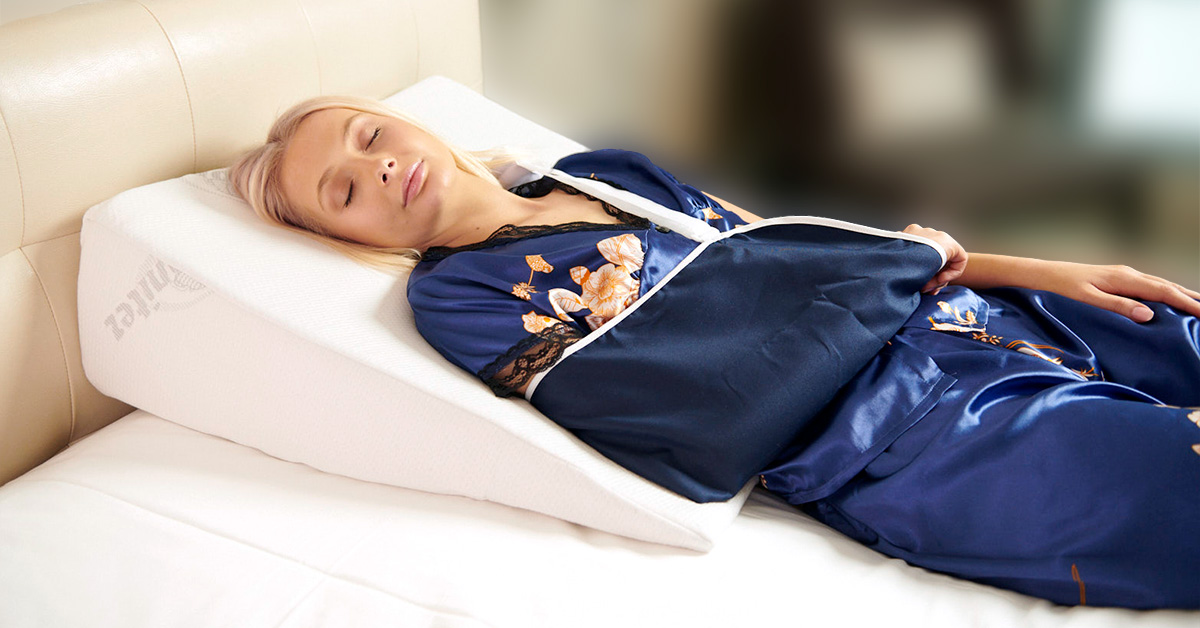Recovering from shoulder surgery can be a challenging process, especially when it comes to finding a comfortable sleeping position that doesn’t aggravate your healing shoulder. A wedge pillow can be a game-changer in this scenario, offering the necessary support to keep you comfortable and promote faster healing. This guide will walk you through the steps and tips on how to sleep on a wedge pillow after undergoing shoulder surgery, ensuring your recovery period is as smooth and pain-free as possible.
Understanding the Importance of Proper Sleep Post-Surgery
Sleep is crucial for recovery after any surgery. It’s during sleep that your body repairs itself. However, after shoulder surgery, finding a comfortable sleeping position is often difficult due to pain, swelling, and the need to avoid pressure on the surgical site. A wedge pillow can help by:
- Elevating the upper body to reduce swelling
- Keeping the shoulder in a stable position to prevent strain
- Reducing pain by minimizing pressure on the shoulder
Choosing the Right Wedge Pillow
Before diving into the specifics of how to use a wedge pillow, it’s important to select the right one. Consider the following when making your choice:
- Incline Angle: Look for a wedge pillow with an angle that keeps your shoulder elevated above your heart, as recommended by your surgeon.
- Size and Width: Ensure the pillow is wide enough to support your entire upper body comfortably.
- Material: Memory foam is often recommended for its ability to contour to your body, providing personalized support.
- Reviews: Use our in depth reviews of the best wedge pillows to make an informed choice.
Setting Up Your Sleeping Environment
Proper setup is key to maximizing the benefits of a wedge pillow. Here’s how to prepare your sleeping area:
- Stable Base: Place the wedge pillow on a stable mattress that won’t shift during the night.
- Extra Pillows: Have additional pillows on hand to provide extra support to your arm and shoulder.
- Accessible Essentials: Keep anything you might need close by, such as water, medications, and your phone, to avoid unnecessary movements that could strain your shoulder.
How to Sleep on a Wedge Pillow After Shoulder Surgery
Positioning Yourself Correctly
- Getting into Bed: Sit on the bed and slowly lower yourself onto the wedge pillow, using your good arm to guide you down.
- Upper Body Elevation: Adjust the wedge pillow so that your upper body is elevated at the angle recommended by your surgeon. This often ranges from 30 to 45 degrees.
- Shoulder Support: Place a small, soft pillow or a folded towel under your injured shoulder for added support and to maintain proper alignment.
Additional Tips for Comfort
- Arm Support: Use a pillow under your arm to keep your shoulder stable and reduce tension. A sling may also be recommended by your doctor for added support while sleeping.
- Adjusting for Comfort: If you feel any discomfort, don’t hesitate to adjust the pillows or your position until you find a setup that feels right.
- Back Sleeping: Try to stay on your back, as this position puts the least amount of pressure on your shoulder. Avoid sleeping on your stomach or the injured side.
Creating an Ideal Recovery Environment
- Cool and Comfortable: Ensure your room is at a comfortable temperature and well-ventilated. A cool environment can help reduce swelling.
- Limit Distractions: Minimize noise and light disturbances. Consider using earplugs and an eye mask if necessary.
- Follow a Routine: Going to bed and waking up at the same time every day can help improve the quality of your sleep, aiding in your recovery.
Managing Pain and Discomfort
- Pain Medication: Follow your doctor’s advice regarding pain medication. Taking your medication before bed can help ensure a more comfortable night’s sleep.
- Ice Packs: Use ice packs as directed by your surgeon to help manage pain and swelling. Be sure to wrap ice packs in a cloth to avoid direct contact with your skin.
- Relaxation Techniques: Techniques such as deep breathing, meditation, or listening to calming music can help relax your body and mind, making it easier to fall asleep.
When to Seek Further Assistance
- Persistent Pain: If you experience persistent or worsening pain despite following these tips, contact your healthcare provider.
- Adjustment Issues: If you’re having trouble finding a comfortable sleeping position even with a wedge pillow, your doctor or a physical therapist may offer additional guidance or suggest alternative sleeping aids.
Conclusion
Recovering from shoulder surgery requires patience and the right support, both of which can be significantly aided by the use of a wedge pillow. By following these detailed steps and tips, you can create a comfortable sleeping environment that supports your recovery. Remember, every person’s recovery journey is unique, so it’s important to listen to your body and consult with your healthcare provider to ensure your sleeping arrangements are conducive to healing. With the right setup and care, you can navigate the recovery process with greater ease and comfort.

